 W
WAlloteuthis media, the midsize squid or little squid is a species of squid in the family Loliginidae from the eastern Atlantic and the Mediterranean Sea. It is generally a by catch species in trawl fisheries, although there is an active fishery in the western Mediterranean.
 W
WAlloteuthis subulata, the European common squid, is a species of squid in the genus Alloteuthis and the family Loliginidae.
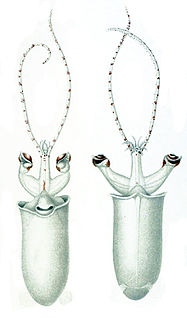 W
WBathothauma lyromma, the lyre cranch squid, is a highly modified species of glass squid from the family Cranchiidae with a distribution which encompasses most of the world's oceans from the tropics to high latitudes.
 W
WBathypolypus arcticus, the North Atlantic octopus, deep sea octopus or spoonarm octopus is a small species of demersal octopus of the North Atlantic. It is usually found at depths of 200 to 600 m (660–1,970 ft) where the temperature is between 2 and 6 °C (36–43 °F).
 W
WCallistoctopus macropus, also known as the Atlantic white-spotted octopus, white-spotted octopus, grass octopus or grass scuttle, is a species of octopus found in shallow areas of the Mediterranean Sea, the warmer parts of the eastern and western Atlantic Ocean, the Caribbean Sea, and the Indo-Pacific region. This octopus feeds on small organisms which lurk among the branches of corals.
 W
WChiroteuthis veranii, commonly known as the long-armed squid, is a species of chiroteuthid squid. It grows to a mantle length of 12.5 cm and a total length of 130 cm.
 W
WChtenopteryx sicula, also known as the comb-finned squid or toothed-fin squid, is a species of squid native to at least the Mediterranean Sea. It is characterised by several distinct morphological features: ocular photophores are present but visceral photophores are absent, arm suckers are arranged in at least 4 series distally, and club suckers are borne in more than 8 series.
 W
WThe common cuttlefish or European common cuttlefish is one of the largest and best-known cuttlefish species. They are a migratory species that spend the summer and spring inshore for spawning and then move to depths of 100 to 200m during autumn and winter. They grow to 49 cm in mantle length (ML) and 4 kg in weight. Animals from subtropical seas are smaller and rarely exceed 30 cm in ML.
 W
WThe common octopus is a mollusc belonging to the class Cephalopoda. Octopus vulgaris is the most studied of all octopus species. It is cosmopolitan, that is, a global species, which ranges from the eastern Atlantic, extends from the Mediterranean Sea and the southern coast of England, to the southern coast of South Africa. It also occurs off the Azores, Canary Islands, and Cape Verde Islands. The species is also common in the Western Atlantic. The common octopus hunts at dusk. Crabs, crayfish, and bivalve molluscs are preferred, although the octopus eats almost anything it can catch. It is able to change colour to blend in with its surroundings, and is able to jump upon any unwary prey that strays across its path. Using its beak, it is able to break into the shells of shelled molluscs. Training experiments have shown the common octopus can distinguish the brightness, size, shape, and horizontal or vertical orientation of objects.
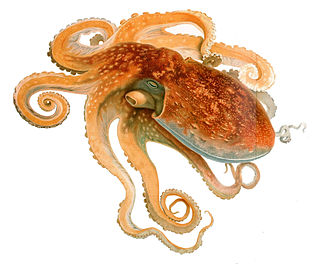 W
WThe curled octopus, also known as the horned octopus, lesser octopus or northern octopus, is a species of cephalopod found in the northeast Atlantic, ranging from Norway to the Mediterranean, including the British Isles. It is of minor importance to fisheries, being mainly bycatch in the north eastern Atlantic and in the Mediterranean where the common octopus is the preferred catch.
 W
WEledone moschata, the musky octopus, is a species of octopus belonging to the family Octopodidae.
 W
WThe European flying squid is a species of squid from the continental slope and oceanic waters of the eastern Atlantic Ocean and the Mediterranean Sea. It is the type species of the genus Todarodes, the type genus of the subfamily Todarodinae of the pelagic squid family Ommastrephidae. It is a species which is targeted by some fisheries, although it is more often a bycatch.
 W
WThe European squid or common squid is a large squid belonging to the family Loliginidae. It occurs abundantly in coastal waters from the North Sea to at least the west coast of Africa. This species lives from sea level to depths of 500 m (1,600 ft). Its mantle is up to 40 cm (16 in) long. The species is extensively exploited by commercial fisheries.
 W
WHeteroteuthis dispar, also known as the odd bobtail, is a small deep water squid found in the North Atlantic Ocean and the Mediterranean Sea.
 W
WHistioteuthis reversa, commonly known as the reverse jewel squid or the elongate jewel squid, is a species of cock-eyed squid, so called because the eyes are dissimilar. It occurs at moderate depths in the Atlantic Ocean and Mediterranean Sea and is also known from the Indian Ocean.
 W
WIllex coindetii, commonly known as the southern shortfin squid or broadtail shortfin squid, is a species of neritic squids in the family Ommastrephidae. They are found in the Mediterranean Sea and on both sides of the north Atlantic Ocean.
 W
WIllex illecebrosus, commonly known as the northern shortfin squid, is a species of neritic squids in the family Ommastrephidae. Squids of the genus Illex account for 65% of the world’s cephalopod captures. Illex is formed by four taxa distributed throughout the Atlantic Ocean, whose identification and phylogenetic relationships based on morphological characters remain controversial.They are found in the northwest Atlantic Ocean, from off the coast of eastern North America to Greenland, Iceland, and west of Ireland and the United Kingdom. They are a highly migratory and short-lived species, with lifespans of less than a year. They are commercially important and are fished extensively, mostly for the Canadian and Japanese markets. Northern shortfin squid is a migratory species of squid with a distribution ranging from Florida Straits to Newfoundland in the Northwest Atlantic Ocean. The species is native to Canada, Greenland, Iceland and United States. The species has an average lifespan between 1–1.5 years in which most live less than a year. The location of the fishery of the squid is mainly in Mid-Atlantic Bight from between summer and fall.
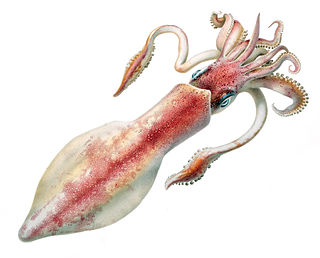 W
WLoligo forbesii, known commonly as the veined squid and long-finned squid, is a commercially important species of squid in the family Loliginidae, the pencil squids.
 W
WMacrotritopus defilippi, commonly known as the Lilliput longarm octopus or the Atlantic longarm octopus, is a small species of octopus, a marine cephalopod mollusc of the order Octopoda.
 W
WMastigoteuthis agassizii is a species of whip-lash squid. It is the type species of the genus.
 W
WAbralia veranyi is a species of squid in the family Enoploteuthidae. Common names include the eye-flash squid, Verany's enope squid and the midwater squid. It is found in the Atlantic Ocean and the Mediterranean Sea. It undergoes a daily vertical migration from deep waters to near the surface.
 W
WNeorossia caroli, the Carol bobtail squid, is a species of bobtail squid belonging to the family Sepiolidae.
 W
WOctopus salutii, or the Spider Octopus, is a species of octopus found in the Mediterranean Sea and Northeast Atlantic, from southern Spain to Morocco. It ranges from 4.0 to 13.0 cm ML in males and 3.5 to 16.5 cm ML in females. Octopus Salutii are found at depths ranging from 100 to 700m however, they are most abundant at depths of 250 to 500m.
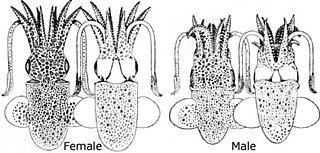 W
WRondeletiola minor, also known as the lentil bobtail, is a species of bobtail squid native to the eastern Atlantic Ocean and Mediterranean Sea. Its natural range covers the northwest of Spain, Portugal, and the eastern, central and western Mediterranean Sea to the southeastern Atlantic Benguela Current off Namibia.
 W
WRossia palpebrosa, also known as the warty bobtail squid, is a species of bobtail squid native to the northern Atlantic Ocean.
 W
WSepia elegans, the elegant cuttlefish, is a species of cuttlefish in the family Sepiidae from the eastern Atlantic Ocean and the Mediterranean Sea. It is an important species for fisheries in some parts of the Mediterranean where its population may have suffered from overfishing.
 W
WSepia orbignyana, the pink cuttlefish, is a species of small cuttlefish from the family Sepiidae. It is occurs in the temperate and tropical waters of the eastern Atlantic Ocean.
 W
WSepietta oweniana is a common marine mollusc from the order Sepiida, the cuttlefish.
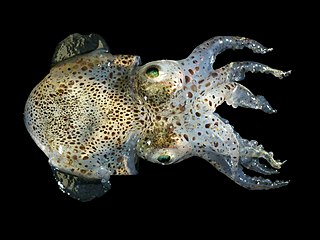 W
WSepiola atlantica, also known as the Atlantic bobtail, is a species of bobtail squid native to the northeastern Atlantic Ocean and the Mediterranean Sea.
 W
WSepiola aurantiaca, also known as the golden bobtail squid, is a rare species of bobtail squid native to the northeastern Atlantic Ocean. It ranges from southern Norway to the western Mediterranean Sea. S. aurantiaca occurs on the outer continental shelf and in the upper bathyal zone. The depth range of this species is possibly from 200 to 400 m.
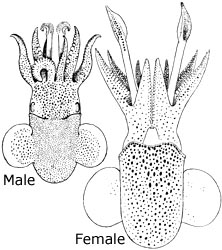 W
WSepiola rondeletii, also known as the dwarf bobtail, is a species of bobtail squid native to the northeastern Atlantic Ocean and the Mediterranean Sea, including the Strait of Sicily, Aegean Sea, Adriatic Sea, Sea of Marmara, and Levantine Sea. In the northeastern Atlantic, its natural range extends from the North Sea to Senegal. Females grow to 60 mm in mantle length, while males are not known to exceed 25 mm ML.
 W
WStoloteuthis leucoptera, also known as the butterfly bobtail squid, is a widespread species of bobtail squid. Its natural range covers the Atlantic Ocean, Mediterranean Sea, and southwestern Indian Ocean. It is distributed from the Gulf of St Lawrence to the Straits of Florida in the western Atlantic and in the Bay of Biscay in the eastern Atlantic. In the Mediterranean Sea, it is specifically found in the northern and southern Tyrrhenian Sea, Ligurian Sea, and off Gorgona Island. S. leucoptera has also been recorded from the Benguela Current off Namibia. There exist unverified records of specimens off eastern Tasmania.
 W
WTeuthowenia megalops, sometimes known as the Atlantic cranch squid, is a species of glass squid from the subarctic and temperate waters of the northern Atlantic Ocean. They are moderately sized squid with a maximum mantle length of 40 cm (16 in). Their very large eyes are the source for the specific name megalops. Like other members of the genus Teuthowenia, they are easily recognizable by the presence of three bioluminescent organs (photophores) on their eyeballs.
 W
WTodaropsis eblanae, also known as the lesser flying squid, is a species of short finned squid in the monotypic genus Todaropsis of the family Ommastrephidae.